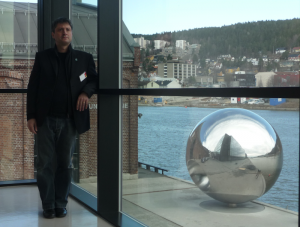Back from the light design conference in Drammen – Norway

Early Saturday’s thoughts of a [mature] astronomer
February 19, 2011
A wonderful concert by Glauco Venier in Cologne
April 17, 2011Busy days… things have [somewhat unexpectedly] changed in my professional life (I’ll blog about this when I’m settled. I just anticipate I’m still an astronomer ;-)), and this comes at a time where many other things are happening.
Our paper on the very old stars was re-submitted after the first pass of the second referee. Now there is one serious point that needs to be addressed, which is the possibility that those stars are actually pre-Main-Sequence stars. I’ll write more in a future post.
Another article on the connection between recurrent novae and Type Ia Supernovae has just been accepted by Astronomy & Astrophysics. This is currently my main field of research, and the work gave me quite some satisfaction. More on this will come if the paper submitted by my colleague Assaf Sternberg will be finally accepted by the prestigious journal Science. But I will get back on this with more details.
Last week, I was in Drammen (Norway), giving the opening speech at the Lighting Design Conference. Here the audience was very much receptive of the issues related to light pollution, and the attitude was very much collaborative. Lots of students were attending, and when I finished the talk there were demonstrations of approval which resembled more those of a pop concert than those typical of an academical environment.
My talk was followed by many very interesting and inspiring presentations. Because the conference was focusing on the Nordic environment, many of the presentations had very nice pictures of the Scandinavian landscape. Very fascinating. There are many things that we, well tempered, intermediate-latitude people tend to ignore about the peculiarities of the Nordic countries. Places where sun and light assume a different meaning.
I also had the honor and the pleasure to meet a famous Scandinavian light designer, Kai Piippo. He gave a intriguing presentation. Two things impressed me more: a) Kai presented the lighting of the Place of Elsinore (yes, that famous Elsinore of Hamlet), where he used a very small amount of light, and yet achieved a wonderful result, and b) he said to me that “the light designer is your best friend“. The statement is less paradoxical than it may seem. He thinks that professional light designers have lots in common with us [astronomers], and we should be talking more than we actually do. I certainly will…
Another nice surprise was meeting again Nevena Kovacevic, a young light designer I met in Stockholm last year. And more of a surprise was learning that, inspired by my presentation in Stockholm, she has been working at a project that included the Milky Way. I can’t say more here, because she is running for some prize and the thing needs to be kept confidential. Here I can only anticipate that she had a brilliant idea, which is using existing street lighting to show stars in the middle of a town. Once the project is finished, I will certainly blog about it. Thanks, Nevena!
The day after coming back from Drammen I left to Goettingen for a week-end with my family. Very nice university town, where very remarkable people lived and taught (Gauss, Born, Hilbert, Minkowski, Planck, Klein, Hahn, …). And, coming back to Munich, driving across a very nice landscape, we passed towns like Halle, Mulhausen, and others. Places where J.S. Bach had spent some time… All in all, an overwhelming week-end.




1 Comment
I am a lighting designer from Miami, USA. Always was faschinated with all forms of natural light, sunlight, lights of distant stars, reflected “moon light” and human made light sources resulting from the technological progress. In our area we have a lot of poor lighting applications where light is spilled all over the night sky creating a huge “halo” effect over the Miami skyline. It’s a problem for the environment (nocturnal animals) and for anyone who favors stargazing. One have to drive in the middle of Everglades to be able to see the starry sky. We do have regulation in place for light polution when it comes to animal habitats (so called turtle laws). Such regulation predominantly deals with light pollution disrupting the natural life cycles of ancient beach nesting turtles. But there is virtually no code enforcement when it comes to light polution at large. I will be interested to know how this is handled in Norway? How strict is the light pollution code there and how it is enforced, if enforced at all?